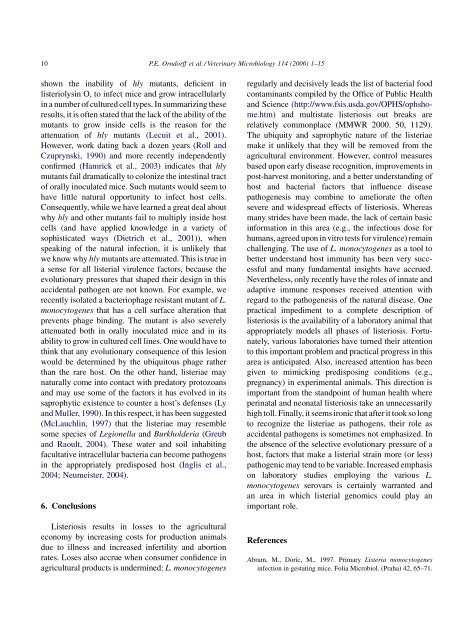Host and bacterial factors in listeriosis pathogenesis - University of ...
Host and bacterial factors in listeriosis pathogenesis - University of ...
Host and bacterial factors in listeriosis pathogenesis - University of ...
You also want an ePaper? Increase the reach of your titles
YUMPU automatically turns print PDFs into web optimized ePapers that Google loves.
10<br />
P.E. Orndorff et al. / Veter<strong>in</strong>ary Microbiology 114 (2006) 1–15<br />
shown the <strong>in</strong>ability <strong>of</strong> hly mutants, deficient <strong>in</strong><br />
listeriolys<strong>in</strong> O, to <strong>in</strong>fect mice <strong>and</strong> grow <strong>in</strong>tracellularly<br />
<strong>in</strong> a number <strong>of</strong> cultured cell types. In summariz<strong>in</strong>g these<br />
results, it is <strong>of</strong>ten stated that the lack <strong>of</strong> the ability <strong>of</strong> the<br />
mutants to grow <strong>in</strong>side cells is the reason for the<br />
attenuation <strong>of</strong> hly mutants (Lecuit et al., 2001).<br />
However, work dat<strong>in</strong>g back a dozen years (Roll <strong>and</strong><br />
Czuprynski, 1990) <strong>and</strong> more recently <strong>in</strong>dependently<br />
confirmed (Hamrick et al., 2003) <strong>in</strong>dicates that hly<br />
mutants fail dramatically to colonize the <strong>in</strong>test<strong>in</strong>al tract<br />
<strong>of</strong> orally <strong>in</strong>oculated mice. Such mutants would seem to<br />
have little natural opportunity to <strong>in</strong>fect host cells.<br />
Consequently, while we have learned a great deal about<br />
why hly <strong>and</strong> other mutants fail to multiply <strong>in</strong>side host<br />
cells (<strong>and</strong> have applied knowledge <strong>in</strong> a variety <strong>of</strong><br />
sophisticated ways (Dietrich et al., 2001)), when<br />
speak<strong>in</strong>g <strong>of</strong> the natural <strong>in</strong>fection, it is unlikely that<br />
we know why hly mutants are attenuated. This is true <strong>in</strong><br />
a sense for all listerial virulence <strong>factors</strong>, because the<br />
evolutionary pressures that shaped their design <strong>in</strong> this<br />
accidental pathogen are not known. For example, we<br />
recently isolated a bacteriophage resistant mutant <strong>of</strong> L.<br />
monocytogenes that has a cell surface alteration that<br />
prevents phage b<strong>in</strong>d<strong>in</strong>g. The mutant is also severely<br />
attenuated both <strong>in</strong> orally <strong>in</strong>oculated mice <strong>and</strong> <strong>in</strong> its<br />
ability to grow <strong>in</strong> cultured cell l<strong>in</strong>es. One would have to<br />
th<strong>in</strong>k that any evolutionary consequence <strong>of</strong> this lesion<br />
would be determ<strong>in</strong>ed by the ubiquitous phage rather<br />
than the rare host. On the other h<strong>and</strong>, listeriae may<br />
naturally come <strong>in</strong>to contact with predatory protozoans<br />
<strong>and</strong> may use some <strong>of</strong> the <strong>factors</strong> it has evolved <strong>in</strong> its<br />
saprophytic existence to counter a host’s defenses (Ly<br />
<strong>and</strong> Muller, 1990). In this respect, it has been suggested<br />
(McLauchl<strong>in</strong>, 1997) that the listeriae may resemble<br />
some species <strong>of</strong> Legionella <strong>and</strong> Burkholderia (Greub<br />
<strong>and</strong> Raoult, 2004). These water <strong>and</strong> soil <strong>in</strong>habit<strong>in</strong>g<br />
facultative <strong>in</strong>tracellular bacteria can become pathogens<br />
<strong>in</strong> the appropriately predisposed host (Inglis et al.,<br />
2004; Neumeister, 2004).<br />
6. Conclusions<br />
Listeriosis results <strong>in</strong> losses to the agricultural<br />
economy by <strong>in</strong>creas<strong>in</strong>g costs for production animals<br />
due to illness <strong>and</strong> <strong>in</strong>creased <strong>in</strong>fertility <strong>and</strong> abortion<br />
rates. Loses also accrue when consumer confidence <strong>in</strong><br />
agricultural products is underm<strong>in</strong>ed: L. monocytogenes<br />
regularly <strong>and</strong> decisively leads the list <strong>of</strong> <strong>bacterial</strong> food<br />
contam<strong>in</strong>ants compiled by the Office <strong>of</strong> Public Health<br />
<strong>and</strong> Science (http://www.fsis.usda.gov/OPHS/ophshome.htm)<br />
<strong>and</strong> multistate <strong>listeriosis</strong> out breaks are<br />
relatively commonplace (MMWR 2000. 50, 1129).<br />
The ubiquity <strong>and</strong> saprophytic nature <strong>of</strong> the listeriae<br />
make it unlikely that they will be removed from the<br />
agricultural environment. However, control measures<br />
based upon early disease recognition, improvements <strong>in</strong><br />
post-harvest monitor<strong>in</strong>g, <strong>and</strong> a better underst<strong>and</strong><strong>in</strong>g <strong>of</strong><br />
host <strong>and</strong> <strong>bacterial</strong> <strong>factors</strong> that <strong>in</strong>fluence disease<br />
<strong>pathogenesis</strong> may comb<strong>in</strong>e to ameliorate the <strong>of</strong>ten<br />
severe <strong>and</strong> widespread effects <strong>of</strong> <strong>listeriosis</strong>. Whereas<br />
many strides have been made, the lack <strong>of</strong> certa<strong>in</strong> basic<br />
<strong>in</strong>formation <strong>in</strong> this area (e.g., the <strong>in</strong>fectious dose for<br />
humans, agreed upon <strong>in</strong> vitro tests for virulence) rema<strong>in</strong><br />
challeng<strong>in</strong>g. The use <strong>of</strong> L. monocytogenes as a tool to<br />
better underst<strong>and</strong> host immunity has been very successful<br />
<strong>and</strong> many fundamental <strong>in</strong>sights have accrued.<br />
Nevertheless, only recently have the roles <strong>of</strong> <strong>in</strong>nate <strong>and</strong><br />
adaptive immune responses received attention with<br />
regard to the <strong>pathogenesis</strong> <strong>of</strong> the natural disease. One<br />
practical impediment to a complete description <strong>of</strong><br />
<strong>listeriosis</strong> is the availability <strong>of</strong> a laboratory animal that<br />
appropriately models all phases <strong>of</strong> <strong>listeriosis</strong>. Fortunately,<br />
various laboratories have turned their attention<br />
to this important problem <strong>and</strong> practical progress <strong>in</strong> this<br />
area is anticipated. Also, <strong>in</strong>creased attention has been<br />
given to mimick<strong>in</strong>g predispos<strong>in</strong>g conditions (e.g.,<br />
pregnancy) <strong>in</strong> experimental animals. This direction is<br />
important from the st<strong>and</strong>po<strong>in</strong>t <strong>of</strong> human health where<br />
per<strong>in</strong>atal <strong>and</strong> neonatal <strong>listeriosis</strong> take an unnecessarily<br />
high toll. F<strong>in</strong>ally, it seems ironic that after it took so long<br />
to recognize the listeriae as pathogens, their role as<br />
accidental pathogens is sometimes not emphasized. In<br />
the absence <strong>of</strong> the selective evolutionary pressure <strong>of</strong> a<br />
host, <strong>factors</strong> that make a listerial stra<strong>in</strong> more (or less)<br />
pathogenic may tend to be variable. Increased emphasis<br />
on laboratory studies employ<strong>in</strong>g the various L.<br />
monocytogenes serovars is certa<strong>in</strong>ly warranted <strong>and</strong><br />
an area <strong>in</strong> which listerial genomics could play an<br />
important role.<br />
References<br />
Abram, M., Doric, M., 1997. Primary Listeria monocytogenes<br />
<strong>in</strong>fection <strong>in</strong> gestat<strong>in</strong>g mice. Folia Microbiol. (Praha) 42, 65–71.

















